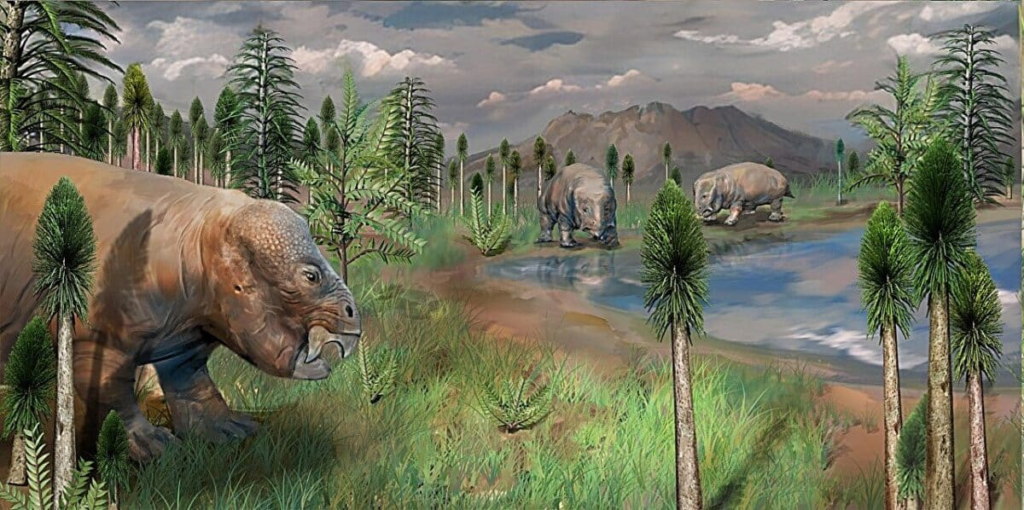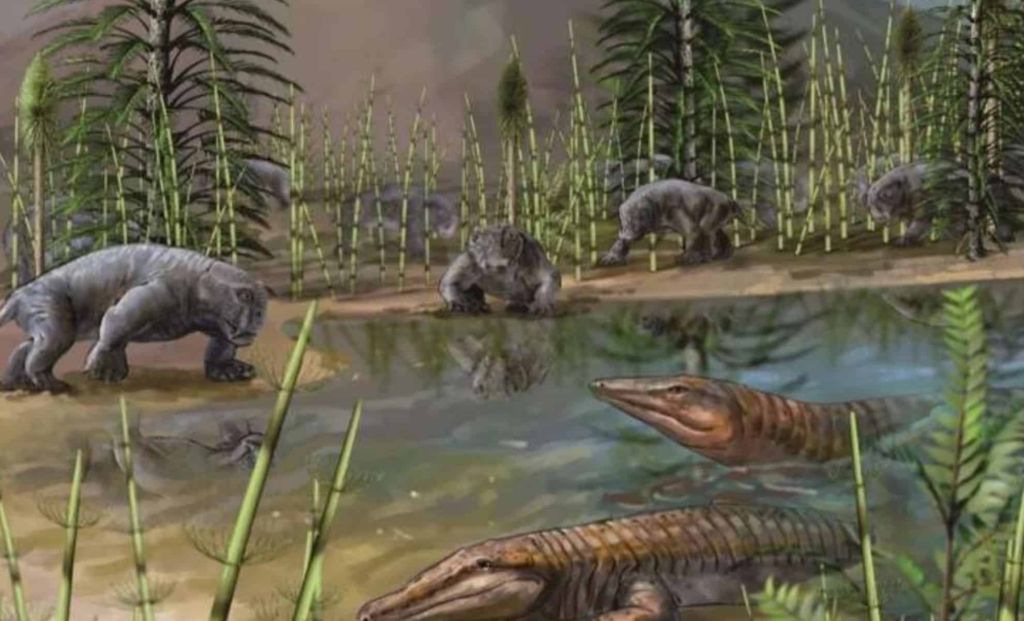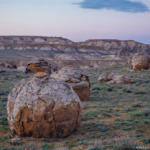Scientists have uncovered a hidden prehistoric ecosystem in China that defied Earth’s deadliest mass extinction, revealing a lost world that thrived while most life perished.

Artistic reconstruction of the terrestrial ecological landscape before the end Permian mass extinction based on fossil palynomorphs, plants , and tetrapods recovered, as well as sedimentological data from the South Taodonggou Section. Credit: Yang Dinghua
Scientists have uncovered a remarkable prehistoric ecosystem that survived the end-Permian mass extinction, the most devastating extinction event in Earth’s history. Located in China’s Turpan-Hami Basin, this “life oasis” provided refuge for plants and animals while over 80% of marine species and vast numbers of terrestrial organisms perished.
The findings, published in Science Advances, challenge the prevailing view that land ecosystems suffered the same catastrophic collapse as marine life. Instead, evidence from fossil pollen, spores, and tree trunks suggests that this region remained largely untouched by the mass extinction, supporting continuous plant evolution and rapid ecological recovery.
The discovery, led by Prof. Liu Feng from the Nanjing Institute of Geology and Paleontology (NIGPAS), offers new insights into how certain environments can act as refuges during planetary crises, a finding that carries profound implications for understanding resilience in the face of modern climate change.
The End-Permian Mass Extinction: Earth’s Greatest Dying
The end-Permian extinction, which occurred 252 million years ago, was caused by massive volcanic eruptions in Siberia. These eruptions released enormous amounts of toxic gases, triggered wildfires, acidified the oceans, and drastically altered global temperatures. The result was the largest mass extinction in history, often called “The Great Dying”, wiping out:
- More than 80% of marine species
- Over 70% of land-dwelling vertebrates
- Countless plant species, altering global ecosystems
For decades, scientists believed that terrestrial ecosystems were nearly as devastated as marine environments, with forests disappearing, food chains collapsing, and entire species vanishing. However, the new research suggests that some land regions, such as the Turpan-Hami Basin, were surprisingly resilient, providing stable ecosystems that helped life recover.

Artistic reconstruction of the terrestrial ecological landscape before the end Permian mass extinction based on fossil palynomorphs, plants , and tetrapods recovered, as well as sedimentological data from the South Taodonggou Section. Credit: Yang Dinghua
A Sanctuary for Life: What the Fossils Reveal
The study focused on the South Taodonggou section in Xinjiang, where well-preserved fossil pollen, spores, and plant remains were discovered. Through detailed analysis, scientists reconstructed a timeline that spanned 160,000 years before and after the extinction event, revealing a continuous presence of ferns and coniferous forests.
Paleontologist Prof. Wan Mingli, who worked on the project, highlighted the significance of the discovery:
“The presence of intact tree trunks and fern stems further confirms that these microfossils represent local vegetation, not transported remnants.”
Unlike other regions where plant life was largely obliterated, the Turpan-Hami Basin maintained a functioning ecosystem, allowing for a much faster recovery than previously thought. The estimated extinction rate of spore and pollen species in this region was only 21%, far lower than the catastrophic losses seen elsewhere.

How Did This ‘Life Oasis’ Survive?
One of the biggest questions is why this region escaped the worst of the end-Permian extinction while others suffered total collapse. The answer appears to lie in a combination of climate stability and geography.
- Consistent rainfall: Analysis of ancient soil samples indicates that the region received around 1,000 mm of rain per year, maintaining lush vegetation even as other areas dried out.
- Geographic isolation: The basin’s location may have protected it from the worst volcanic effects, such as acid rain and atmospheric toxins.
- Riparian ecosystems: Rivers and wetlands provided freshwater and shelter, acting as natural buffers against climate extremes.
According to lead author Prof. Liu Feng, these factors allowed the region to act as a biological stronghold:
“This suggests that local climate and geographic factors can create surprising pockets of resilience, offering hope for conservation efforts in the face of global environmental change.”

